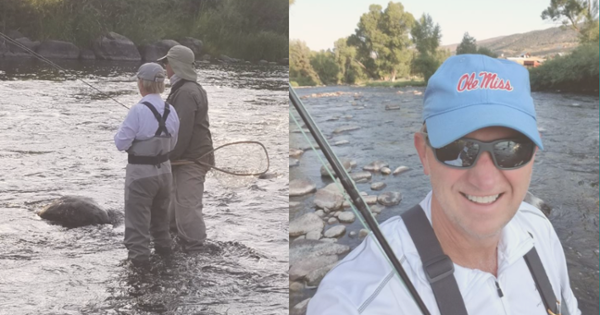This past summer, CeCe and I took a trip to Beaver Creek Resort in Colorado with my brother, Mike, and his wife, Joy. As part of the trip, we planned a fly fishing excursion. CeCe loves to fly fish. When we arrived, the weather abruptly changed for part of the week so we adjusted our fishing days. We also discovered that it was low water due to drought and we could only fish half a day due to the stress on the fish. Later, we experienced that when the water is low, lots and lots of slippery moss forms on the rocks. So when you combine moving water with slippery rocks, you get a tough time fishing.
As we got going that morning with our guide, it was tough wading from the very start. Slippery moss everywhere; slow going for sure. Unfortunately, CeCe lost her footing and slipped and fell in deep enough to get water in her waders. Wow, I’m thinking this is going to be a short fishing trip! She took off her waders, poured the water out, put on some dry leggings and went right back to fishing — now that’s a fisherman!
As I fumbled and splashed my way across the stream to the deeper water, I realized just how scary and truly freezing that water was. I learned to move more intentionally, one foot at a time, moving deliberately toward my destination. I’d completely plant my foot and even wiggle it some to settle on the rocks on the bottom. It was evident not all rocks were good for navigating the intense conditions, so I began to look for rocks I could depend on to get me safely to my next fishing spot. As long as I constantly kept contact with a base rock, I could move forward. As I got to even deeper water, the challenge was no longer the moss, but the increasing strength of the water. So again, I learned to stay grounded, one foot at a time, so I never had too much in motion. When I found a solid flat rock, I settled in and began fishing. Once I established my foundation, I began to have success with catching fish. Now, I’ve had much better trips both in quantity of fish caught and ease of fishing but as our guide pointed out, we caught more rainbow and brown trout in the first two hours than his group did all morning the day before. By the way, the guide who fishes every day shared with us that he fell in the day before, so we weren’t alone in our struggles- ha!
This experience is a great analogy for where we are as a profession. We face lots of challenges just like my group did on our fishing trip. We are dealing with slippery moss manifested in talent shortages, increased turnover in our staff and steep learning curves for new skills. The swift current is manifested in the exponential technology changes. Our compliance services are being commoditized resulting in low water conditions. The fishing conditions are causing many of us to become extremely cautious.
But, there are lessons to be learned here.
First, we can understand how important it is for us to know about the fishing conditions—we need to be aware of the weather forecast, the swiftness of the current, the water level and the obstacles like slippery moss. When we’re aware, we can predict and adapt how we wade the stream and successfully catch fish. What are our fishing conditions as you see them today?
Second, we need to identify the sturdy rocks we can count on to navigate the stream and stand on so we can fish. What are the rocks for our profession and our firm that provide stability during tough fishing conditions?
Third, even in harsh conditions, we can catch good fish. If we want to catch the stringers of fish we have caught in the past, we simply need to adjust our fishing to allow for the changing conditions. Just like we had success in catching fish, our profession is positioned to catch lots of fish if we’re #FutureReady.

